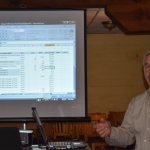CRC, VDEQ discuss grants
Published 10:19 am Wednesday, September 5, 2018


Members of the Commonwealth Regional Council (CRC), area planning and zoning directors and state officials learned about ways their counties can take part in keeping their area waterways free from pollutants during a meeting held at The Mill Room in Farmville Thursday.
While Lunenburg County’s rivers and streams are not among those that flow into the Chesapeake Bay, the county has an opportunity to benefit from state assistance programs that can fund localities looking to take on stream restoration programs or other programs meant to help area waterways.
Those in attendance included CRC Executive Director Melody Foster; Virginia Department of Environmental Quality (VDEQ) Chesapeake Bay Coordinator James Davis-Martin; Ed Dunn, environmental health manager with Piedmont Health District; Kirby Woolfork with Virginia Department of Forestry; Buckingham County Zoning and Planning Administrator Rebecca Cobb; Cumberland County Planning and Zoning Director J.P. Duncan and Ashley Hall and Kendall Effler with Stantec, an engineering and design company working with Virginia Department of Transportation to provide stormwater infrastructure to protect roadways.
Trending
The watershed implementation plan is a non-binding item, meaning that the state cannot enforce localities to participate. Foster said the plan acts more like a wish list to justify funding needs to the Virginia General Assembly.
The council previously discussed participating in the watershed program after being contacted by VDEQ and hosting a previous meeting about the program earlier in the summer.
Cam Johnson, regional planner for CRC, gave an overview of the Virginia Department of Environmental Quality’s (VDEQ) third phase of its watershed implementation plan, which includes creating a Total Maximum Daily Load (TMDL) program for the Chesapeake Bay. The TMDL was designed to help implement restoration efforts to lower pollutions in the bay and surrounding rivers and streams. The VDEQ will submit the third phase of its watershed implementation program to the United States Environmental Protection Agency (EPA) later this year.
Regional localities can help with this effort, Johnson and Davis-Martin said, by creating Best Management Practices (BMPs), or efforts to reduce pollutants from entering area rivers.
On a regional level, rivers and streams that impact this study include the Appomattox River in Farmville, the James River’s course in Cartersville and Deep Creek in Mannboro.
Johnson compiled data from the DEQ’s 2017 findings for Cumberland, Buckingham, Prince Edward, Amelia and Nottway counties, which calculate and project changes in levels of nitrogen, phosphorus and sediment for each county of what the levels could be in 2025 and the sources of the pollutants.
Trending
For all counties, the projected percentages of changes in nitrogen, phosphorus and sediment all showed decreases. The only projections that saw increases were pollutants that came from regulated construction. All counties received projected increases for pollutants due to regulated construction.
Johnson and Davis-Martin said the estimates are not precise, particularly when asked about the high percentage rates of nitrogen, phosphorus and sediment caused by projected regulated construction. They said the percentages can be used as a guide, and for counties interested in participating, their efforts could help protect their rivers’ health and the health of the Chesapeake Bay.
“Water quality is important in the region,” Johnson said. “It’s important to be proactive in implementing Best Management Practices in the region that reflect the interest of localities and as a region.”
He said implementing these programs can have more than one benefit. For example, he said if a locality begins practicing street sweeping, removing debris or litter from roadways, he said this can improve water quality in addition to preventing flooding through clear storm drains.
Davis-Martin discussed the Stormwater Local Assistance Fund (SLAF) through the VDEQ, a grant program that offers local governments grant funding for larger-scale stream restoration projects and stormwater BMPs.
Davis-Martin estimates approximately $20 million funding available through the program.
Buckingham County Board of Supervisors District Four Supervisor Morgan Dunnavant asked whether a similar grant could be used for the Drakes Branch flood study in Charlotte County and subsequent plans to move buildings away from the flood site.
Foster said the town is in the process of submitting a grant application for the Virginia Department of Emergency Management (VDEM) Mitigation Assistance Grant Program, but said the CRC could consider the SLAF grant as an option as well.
CRC Deputy Director Todd Fortune noted that the program is operated by VDEM, but the grant funds come from Federal Emergency Management Agency (FEMA), and he said FEMA requires a 25-percent non-federal match.
“SLAF might be a possibility if the stream restoration project is designed in a way to both mitigate flooding and reduce nutrients,” Davis-Martin said.
“We will definitely do that,” Foster said about looking into the SLAF grant, saying the CRC has worked with Drakes Branch for more than a year in mitigating the flooding issue.
Fortune asked if SLAF is only eligible for areas specific to the Chesapeake Bay watershed, noting that Charlotte County is not considered in that area.
Davis-Martin said he believes the program is statewide.
To learn more about SLAF, visit www.deq.virginia.gov/Programs/Water/CleanWaterFinancingAssistance/StormwaterFundingPrograms/StormwaterLocalAssistanceFund(SLAF).aspx.






